If you have ever noticed that your biscuits or your monthly grocery bill seems costlier than it used to, you have already experienced inflation. But what…………..

If you have ever noticed that your biscuits or your monthly grocery bill seems costlier than it used to, you have already experienced inflation. But what is inflation, how does it affect a country or economy, and why does it matter so much? Let’s break it down.
What is inflation?
Inflation is the increase in the price of goods and services over time, and the decrease in the value of money. In simple words, your money will buy fewer goods or services compared to the past at the same expense. For example, if something was costing you 100 last year but the same thing costs you 110 this year, that makes a 10% increase in the price due to inflation.
What cause inflation?
There are a lot of reasons for inflation to happen: increased production costs due to higher prices of raw materials, labour, or market disruption. Higher demand can also lead to higher inflation—when the demand increases, the prices of goods or services rise because supply remains the same. Certain monetary policy or fiscal policy also affects inflation.
There are many potential root causes of inflation but the most common ones are:
Demand pull inflation
When demand for goods and services increases and supply is limited, then the prices of goods and services go up. Example: in the festive season the prices of products increase because a lot of buyers are ready to purchase. Consumer trends also affect demand pull inflation. For example, when the unemployment of a country is low, people are earning money and then they spend money on things they want to buy. But if unemployment is on the higher side, people are not earning enough, they will not spend money, they try to save money.
Cost push inflation
Cost push inflation occurs when the production costs are increased due to raw materials or wages, then the price of goods increases while the demand is the same. The increased production cost will be transferred to the consumer, and because of this reason also the prices of goods increase.
Built in inflation and rising wages
Built in inflation occurs when people start expecting prices to keep rising. Here is how it works. If the prices of things keep rising, workers expect them to rise further and ask for higher wages to maintain their lifestyle.
Businesses have to pay extra wages, which increases the production cost. To cover this cost, businesses transfer it to customers, then the prices of goods increase. Meanwhile, when wages increase, people have more money in hand, they spend that money, and it increases the demand for products, which pushes the prices higher.
Is inflation good or bad
Good (to some extent): a little inflation around 2 to 3% is considered healthy for the economy. It encourages people to spend money and invest money in asset classes rather than holding it.
Bad: when inflation keeps rising it will affect the economy. People are not comfortable spending money or investing, and people’s savings lose value. Essentially things become expensive, and it hurts middle class and low income families.
Real life examples
In India, an increase in the price of tomatoes and onions makes a headline because even a small hike in price affects millions of families.
Globally, countries like Venezuela and Zimbabwe are facing hyperinflation. In these countries, the prices of goods and services double every few days, and money is almost worthless.
How inflation is measured?
Government uses indexes like the Consumer Price Index (CPI) to track inflation. CPI looks at changes in the prices of everyday items like fuel, food, clothing and housing.
Final thoughts
Inflation is like salt in food, a little is necessary but too much spoils the taste of the dish. While we can’t avoid it, we can plan our finances accordingly. And understanding inflation helps us to make better decisions in our financial life.
